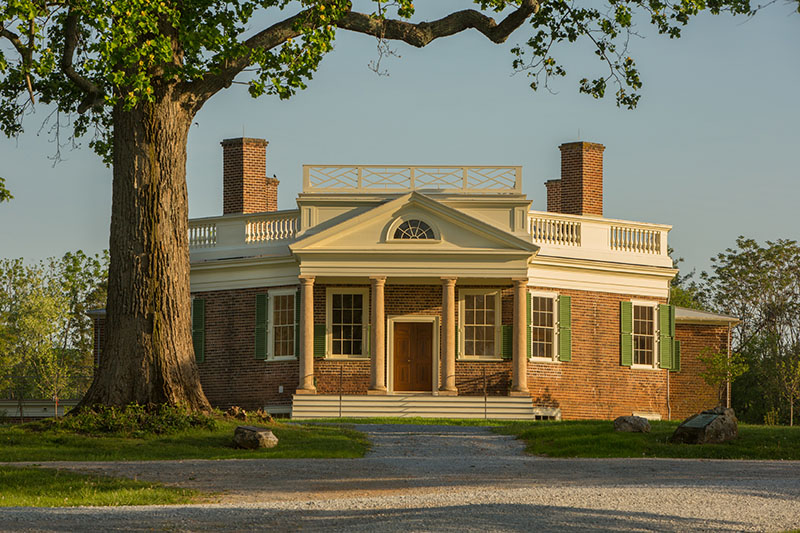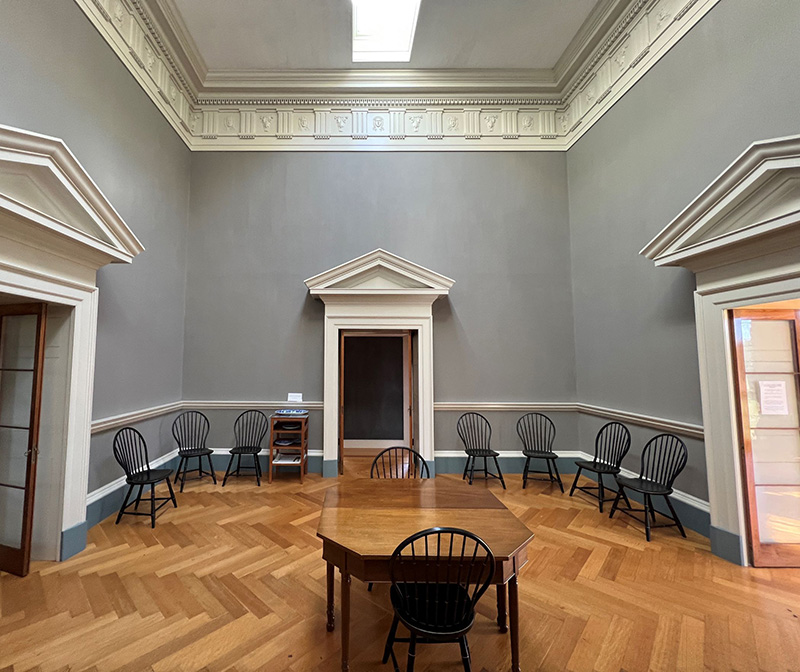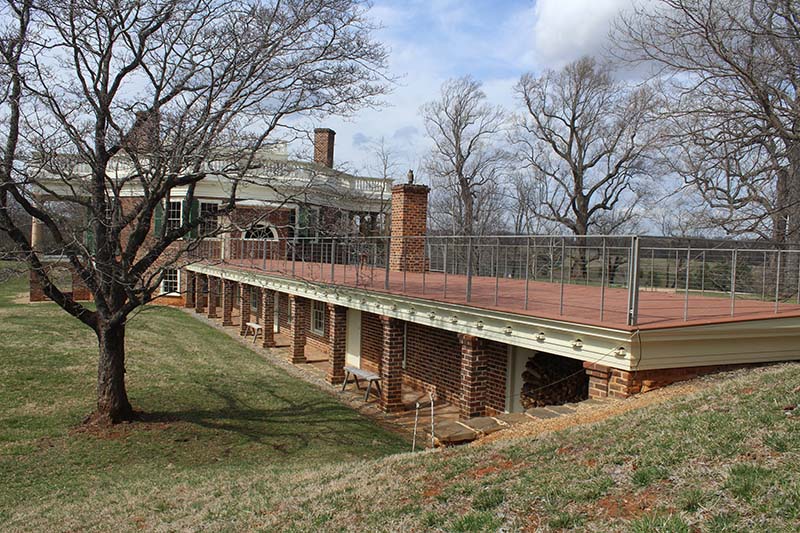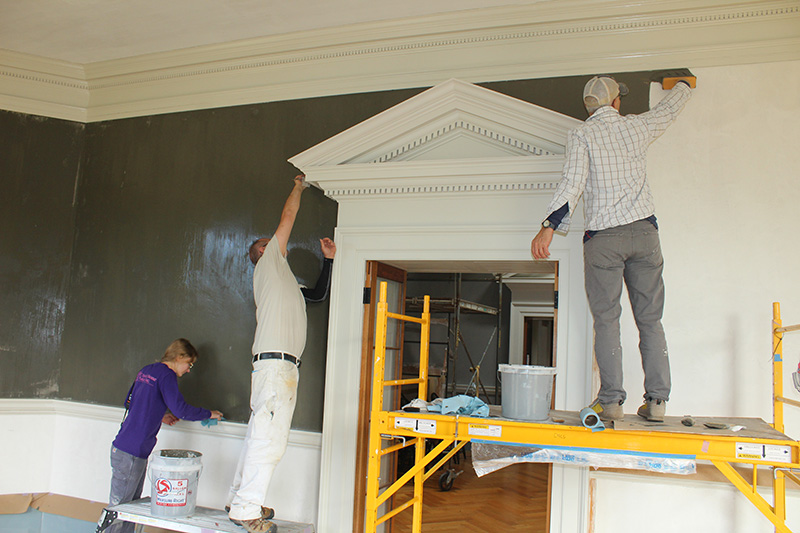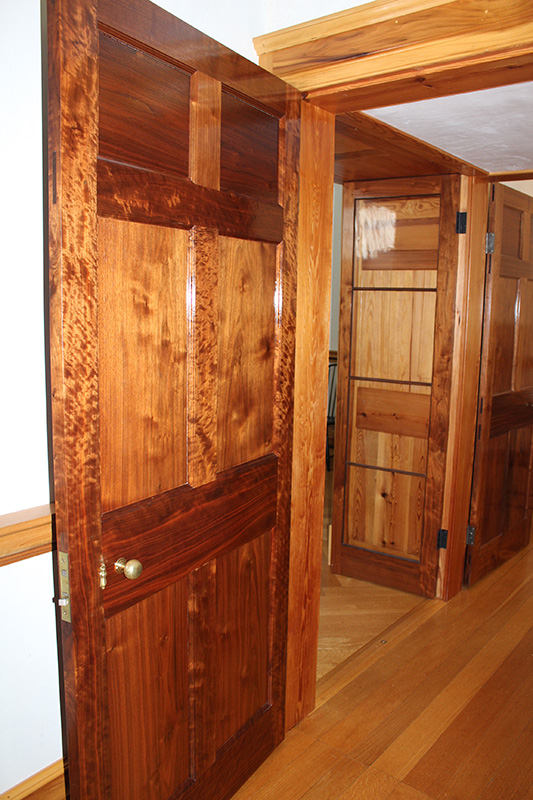Jefferson’s Retirement Masterpiece: Restoring Poplar Forest
by Travis McDonald
Forty years ago, a small group of local preservationists banded together in Lynchburg, VA, to rescue one of Thomas Jefferson’s most important works of architecture. Poplar Forest (figure 1) was his second home, used as an intimate retirement retreat. He slowly crafted the house to perfection over 14 years. The site represents the missing link of Jefferson’s principal architectural accomplishments as well as a largely unknown chapter of his life in retirement. The long, slow restoration of Poplar Forest has also been an ambitious undertaking, and in 2023 we celebrate the completion of that 32-year journey. Although the process of restoring Poplar Forest has been on display to visitors for many years, the impact of Jefferson’s aesthetics, this architectural “melting pot” comprising his own brand of classicism, can now be fully experienced and appreciated.
In his second term as president, Jefferson started construction of this villa retreat on a remote plantation in Bedford County, a three-day journey from Monticello. He even dropped his presidential duties in 1806 to travel to the site to help the bricklayer lay out the foundations of the special shape: a full-size octagonal plan (figure 2). Jefferson acquired his love of octagons from British Palladian architecture books while a college student in the 1760s. He timed the construction of this retreat so that he could begin using it in 1809 after retiring from public life, albeit an unfinished shell at that time. He knew too well that Monticello would not allow him peace and quiet: too many known and unknown visitors called upon him there.
Jefferson primarily came to Poplar Forest alone with Burwell Colbert, his enslaved servant. He was occasionally accompanied by teenage granddaughters, and only invited three foreign friends to stay there.
He could have built a simple, rustic house. Instead, Poplar Forest became one of Jefferson’s most perfect works, intended for his own late-in-life inspiration and enjoyment. He used the retreat two to four times a year for two weeks to two months at a time.
With the marriage of his grandson Francis Eppes in 1823, Jefferson offered the house as a wedding gift. Eppes and his wife lived there for five years before selling it in 1828 to a neighbor and moving to northern Florida.
Jefferson’s death in 1826 saved him the disappointment that his beloved house left the family. The Cobbs-Hutter family owned Poplar Forest from 1828 to 1946, with the property reduced from 5,600 acres to 1,000. The first big change occurred in 1846 when the family rebuilt the house after a disastrous fire the previous year. They made “valuable improvements” to convert Jefferson’s very modern and unusual house into a simple Greek Revival farmhouse.1 From 1946 to 1979 the Watts family became the final owner-occupants and modernized the house, opening eight bricked-up windows and restoring one room in a Jeffersonian style. Those changes in 1846 and 1946 necessitated the intensive investigation and restoration process.
Lynn Beebe, hired in 1986 as the non-profit’s Executive Director, turned to Hugh C. Miller and Nicholas A. Pappas, chief architects for the National Park Service and Colonial Williamsburg, respectively, for guidance on planning a restoration project. Beebe assembled a stellar advisory panel to help select the restoration team. I was chosen as the Director of Restoration, and Mesick Cohen Waite (later Mesick Cohen Wilson Baker) was hired as the consulting architect firm, as they were restoring buildings at Monticello and the University of Virginia.2
The project was ideal for several reasons. The corporation’s board of directors allowed the professional team full control of the process without artificial deadlines, the nemesis of most restoration projects. Following Colonial Williamsburg’s lead, all of the presidential house museums in Virginia have been private nonprofit entities that have adhered to the best restoration practices. Poplar Forest is no exception.
Secondly, the project has been guided by a treasure trove of documentation. When then-President Jefferson was stuck in Washington for two years, he supervised construction via explicit letters. Jefferson was one of the most experienced builders in America, having started that precocious role with Monticello in 1769. Although he traditionally designed and specified all the elements and materials and then supervised the work and the workers, the timing of the Poplar Forest project required a different approach and resulted in a rich written record. Workers’ letters sent to Jefferson at the White House were just as important to the process, making this one of the best-documented early American houses.
The correspondence between Jefferson and enslaved house joiner John Hemmings, who worked independently at Poplar Forest, is especially rare. Hemmings produced the trim with his three nephew apprentices, Jefferson’s bi-racial sons with John’s sister Sally Hemings: Beverly, Eston, and Madison Hemings (the spelling they used for their last name). These young men worked under the direction of their uncle for their unacknowledged father for ten years.
Documentary research by architectural historian S. Allen Chambers was in hand before the process of physical investigation began in 1990. By 1992, the evidence revealed far more than expected, enhancing the documentary record and revealing the contributions of the bricklayers and carpenters hired to work at Poplar Forest and Jefferson’s other buildings.
Thirdly, the decision to use Jeffersonian materials and building techniques and restore features that followed Jefferson’s original plans made this project unique. Even though Jefferson was an older man building a second home, he patiently executed his vision, which included materials that were ordered from Europe. Jefferson’s workshops were at Monticello, and goods and workers traveled back and forth, using Poplar Forest as their workspace. Our restoration craftsmen worked as Jefferson’s did, treating contemporary visitors to an up-close view of restoration.
The project started with the exterior shell, restoring brickwork; rendering the brick columns to resemble stone; installing windows and doors; and building the entablature, pediments, and balustrade missing since 1845. The Chinese railing around the top “terras” roof deck and skylight (figure 2) was only known from a letter by John Hemmings. Once work moved inside, the biggest challenge was returning the central Dining Room to a 20-foot cube (figure 3) by removing an attic level inserted in 1846. The historical sequence then called for reconstructing and restoring the 100-foot service wing on the east side of the house (figure 4), featuring Jefferson’s special “terras” roof deck, his only architectural invention.
Traditional lime plaster was applied to interior brick walls and ceilings. Hand-molded classical trim was made using antique tools and Jefferson-era poplar lumber from the site. The final process was the application of traditional paint finishes for the plaster walls and wood trim (figure 5), hand-made on the site by Chris Mills and Erika Sanchez-Goodwillie. Susan Buck analyzed hundreds of samples to pinpoint the distemper, oil, and pigmented lime wash finishes on the plaster walls, which now provide the final extraordinary color aesthetics that accompany Jefferson’s pallet of golden European-style oak floors, rich varnished walnut window sashes, and the shellacked Virginia walnut doors (figure 6) made by the Hemings family.
This was a very modern house for Virginia and America, described by Englishman George Flower as resembling a French château. English sculptor William Coffee, who made the entablature ornaments for the Dining Room in New York City, even questioned Jefferson about one detail. Jefferson added bucrania (ox skulls) to alternate with the face of Apollo for the Doric order entablature he copied from the Baths of Diocletian (figure 7). Jefferson explained that he could indulge this
fanciful pattern because this was his private home. The room was indeed a most extraordinary space that exhibited Jefferson’s well-developed tastes.
A visit to Poplar Forest will most likely always remain an architectural experience. The furnishings are mostly undocumented. Those few that are known were reproduced, including the three-part octagonal dining room table, the revolving round-top table, and 36 Jefferson-designed Windsor chairs (figure 8). In this rare house museum, however, windows can be opened and louvered blinds used, creating a more realistic atmosphere in which to now fully see and appreciate Jefferson’s personal creation.
- Christian J. Hutter to Edward S. Hutter, 30 Sep 1846; Hutter Family Papers.
2. For more than 30 years, John Mesick and Jeff Baker have provided the connecting link of unparalleled knowledge working at all three of Jefferson’s most personal works in what can be called a golden era of Jeffersonian restoration.
Travis McDonald is the Director of Architectural Restoration of Poplar Forest. His new book about Poplar Forest will be published by the University of Virginia Press in spring 2023.
A print version of this article was published in The Magazine of the Decorative Arts Trust, one of our most popular member benefits. Join today!

